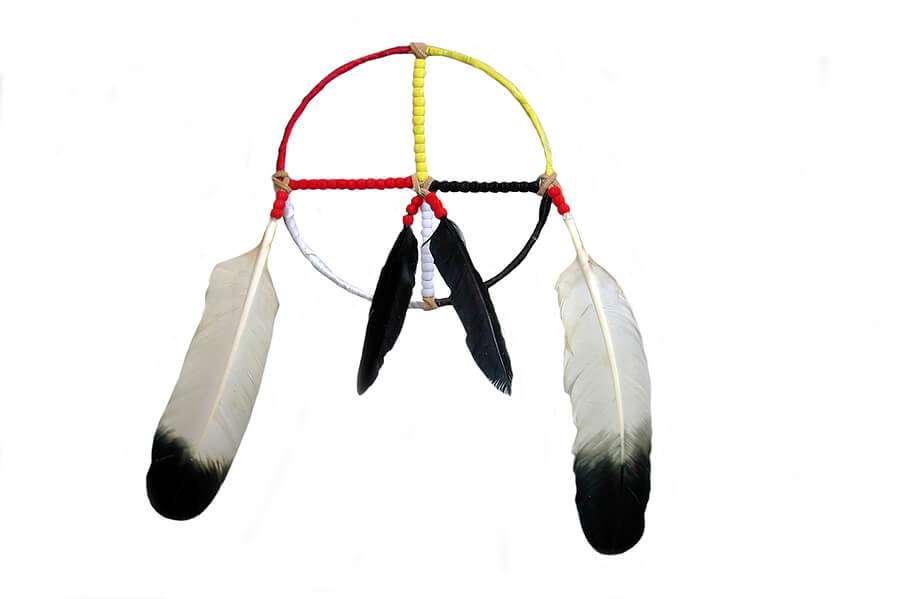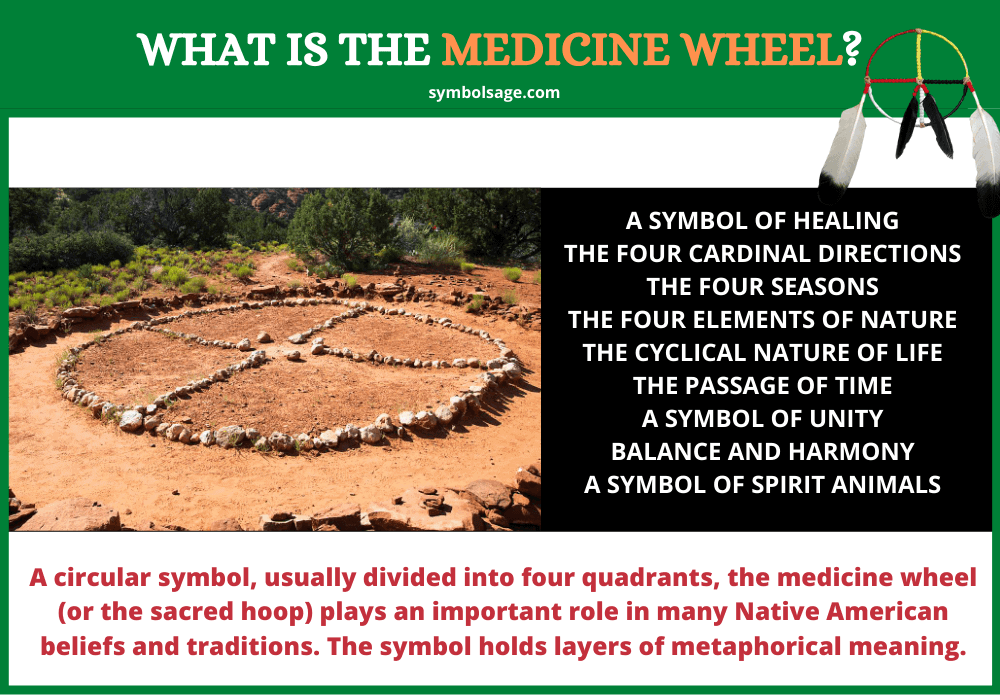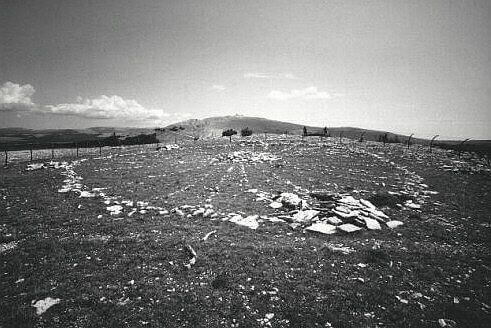
Table of Contents
A circular symbol usually divided into four quadrants, the medicine wheel, sometimes called the sacred hoop, plays a role in many Native American beliefs and traditions. The symbol was used in many ways, but primarily for health and healing. It’s believed to hold layers of metaphorical meaning. Let’s take a closer look into the origin and significance of the symbol.
History of the Medicine Wheel
The Medicine Wheel features a circle with a cross in the center, similar to the ancient solar cross. Many ancient cultures built stone structures as sacred architecture, and the Native Americans were no different. They constructed Medicine Wheels by creating the pattern on the ground with carefully arranged stones. Some of these can still be found in the grasslands of Canada, such as in Alberta and Saskatchewan, as well as some regions in the United States, especially at the Bighorn Mountains in Wyoming.
Archeologists believe that the medicine wheel originated in the Late Prehistoric Period, as some of the wheels have been dated to around 4000 B.C. The Majorville Cairn in Alberta is believed to be the oldest, at 5,500-year-old.
Originally, the symbol was referred to as the sacred circle, but eventually called medicine wheel by non-Native Americans. Wheel suggests that the structures are circular and shaped like a wagon wheel. Ancient medicine wheels have different number of spokes or lines of rocks radiating from the center to its outer edge, ranging from four to twenty-eight.
The term medicine wheel isn’t an indigenous term for the structure—it was first used to describe the Bighorn Wheel, one of the large medicine wheels of ancient construction, but eventually was used to refer to other stone circles with spokes. It’s important to note that in the Native American context, the term medicine means magic or supernatural. It also denotes that the structure has religious significance, as it has been used by tribes to represent all knowledge of the universe. According to Medicine Wheel: An Ancient Symbol in Modern Society, the Native Americans’ interpretation of medicine or health is more connected with philosophy and religion, rather than healing itself.
Uses of the Medicine Wheel
It’s easy to confuse the medicine wheel with the western concept of medicine and healing, but as we’ve already mentioned, its symbolism extends beyond that. Here are some of the purported uses of the medicine wheel.
A Calendar and Astronomical Observatory
According to some scholars, these structures were used as calendars and markers for astronomical events. The twenty-eight spokes of the Big Horn Medicine Wheel indicate that it was designed to count the number of days in a lunar month.
Some also believe that it was built to show the point of the summer solstice sunrise. The medicine wheel at Moose Mountain in Saskatchewan, Canada marks the summer solstice, as well as the rising point of stars such as Sirius and Aldebaran.
As a Religious Architecture
Celestial bodies such as stars, moon, and sun have a significant role in creation stories of Native Americans.
Some archeologists suggest the medicine wheels were used as a sun dance circle, or even a site for the Morning Star ceremony of the Skidi Pawnee, which were performed in accordance with certain astronomical constellations.
It can also be assumed that different tribes used them in different ways including for vision quests (seeking guidance from a future guardian spirit) as well as a solitary spot for praying or meditating.
As Memorial Markers
It was a custom to build burial sites for famous warriors at their deaths, and medicine wheels served as memorial markers for Blackfoot war chiefs. According to some archeologists, the structures were constructed where the warrior had died or had been buried.
Meaning and Symbolism of the Medicine Wheel

Medicine wheels were built to represent the core values of Native Americans—but they eventually became a representation of different spiritual concepts, traditions, and beliefs. Its significance is culture-specific, but here are some of them:
- A Symbol of Healing – The medicine wheel is considered a powerful symbol of holistic healing. The four sections of the symbol can represent the spiritual, emotional, physical and mental aspects of a human’s life experience. By addressing these four areas, one can achieve holistic wellness on one’s journey through life.
- The Four Cardinal Directions – Ancient cultures used the medicine wheel as a guide to cardinal directions. Nowadays, the wheels are commonly illustrated with four quadrants, which symbolizes the four directions: north, east, south, and west.
- The Four Seasons – In some cultures, the medicine wheel is represented with four quadrants of different colors, to signify the four seasons: spring, summer, fall, and winter.
When it comes to the color of each quadrant:
- Yellow symbolizes spring as the time of rebirth and renewal
- Red symbolizes summer as the time of youth
- Black symbolizes fall as the metaphor of maturity
- White symbolizes winter as death
- The Four Elements of Nature – In some teachings, it symbolizes the fire, earth, water and air. The elements might have different interpretations, but generally, the fire represents warmth; the earth represents the foundation of life; the water represents tranquility and healing: and the air represents the life-giving force.
- The Cyclical Nature of Life – In some contexts, the medicine wheel symbolizes the never-ending circle of life such as birth, death, and rebirth. In philosophy, it represents the emotional, physical, intellectual, and spiritual aspects of life that are dependent on each other.
- The Passage of Time – The Native Americans used the medicine wheel as a calendar to mark the summer solstice, as well as other religious ceremonies that were performed in specific time such as the Sun Dance. Metaphorically speaking, it represents time that has no true beginning or end.
- A Symbol of Unity – In ancient times, the medicine wheels were used as an astronomical observatory, showing that everything in the universe is part of a whole.
- A Symbol of Balance and Harmony – In some contexts, it’s used as a reminder to keep different areas in life balanced, including life purpose, family, relationships, and health.
- A Representation of Spirit Animals – Some people associate the eagle, wolf, buffalo, and bear with the medicine wheel. While the eagle in the yellow quadrant represents power and ability, the wolf in the black quadrant represents intelligence and freedom. The buffalo in the red quadrant represents emotional courage, while the bear in the white quadrant represents strength.

Medicine Wheel in Modern Times
While medicine wheels remain significant as part of the archeological landscape and a place for camping and sky watching, some of these still serve as religious sites for tribal ceremonies and modern-day rituals.
Nowadays, the medicine wheel is a universal symbol to represent various philosophies, teachings, and beliefs. It’s also regarded as the Jungian mandala or the symbol of wholeness by psychologists, appearing in various texts from self-help books to introspection tools.
In jewelry design, the medicine wheel is often depicted with four quadrants of different colors. Some are adorned with gemstones, feathers, arrowheads, bones, seashells, and other symbolism. It’s also a popular motif in fashion items and tattoo designs.
In Brief
From its roots as a Native American symbol, the medicine wheel has grown in popularity. In modern society, it represents the cyclical nature of life, balance and harmony, as well as various complex philosophies and beliefs, and is considered a powerful symbol of healing.









